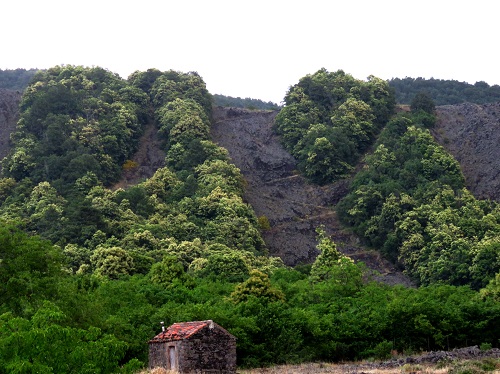First of all, we must say that there is no single type of lava from Mt. Etna. Or rather, over the millennia this material has changed constantly. It depends on the development of the volcano and the point – in the depth of the earth’s crust – from which the magma was taken. Mount Etna emerged from the sea half a million years ago with basaltic eruptions. Around 100,000 years ago a new volcanic complex began to erupt viscous, granite lava. Later it alternated again basalt with tuffaceous lavas. Finally, in the modern era it has returned to erupt basaltic lavas. And in the future …? It will be all to be discovered.
Mount Etna’s lava and its various aspects
Lava is the magma – molten rock – that has reached the earth’s surface, losing almost all of its gases along the way. If the magma has a high quantity of silica, that is, it is “granitic”, when it reaches the surface it generates very viscous lavas. These harden forming domes or spiers. There are also “andesitic” lavas, a neutral type that is placed between the viscous and the fluid ones.
If the magma is poor in silica, it generates more fluid lavas. And in this case they are called “basalt”. In recent centuries Mount Etna’s lava has been mostly basaltic, which in turn has a subdivision. It can be corded lava (due to the cordon shape), leathery or very rough blocks, columnar basalts (similar to corded lavas but in vertical position), pillow – typical of submarine eruptions.
 Ripe della Naca lava falls-ph G Musumeci
Ripe della Naca lava falls-ph G Musumeci
A unique lava
Each volcano has characteristics that make it unique, and even Etna has its own “identity card”. Mount Etna’s lava, although belonging to the “basaltic” type, fluid, typical of effusive eruptions, is the protagonist of Strombolian episodes. Although it has a fluid origin, it proceeds much more slowly on the territory than the lavas of its type.
This for example sometimes involves a rapid cooling of the surface which creates the oven effect inside, allowing the lava to “ingrotiate”. So it continues to flow fluidly downstream. On Etna there are dozens of caves born from these lava tunnels. However, if this does not happen, the lava will advance more and more slowly. And this allows the places threatened by the eruptions to save things and people well in advance.
Mount Etna’s lava is very rich in iron. This is demonstrated by the red-orange colour that rocks take inside when they cool down. The surface is sharp and sparkling, thanks to the glassy elements that compose it. It also contains microscopic gold particles. It is not uncommon that, when walking inside an expanse of lava rock, some magnetic or electronic objects won’t work properly. This is due in fact to the high amount of iron dust.
An artistic resource
For centuries, the men who colonized Etna have used its lava rock for dozens of purposes. To build, above all. Roads, walls, foundations … here everything bears the imprint of the volcano’s basaltic lava. Lava can be sculpted – despite being among the hardest stones in the world – to take the shape of statues, tables, architectural decorations.
Until the 1990s, some master craftsmen were allowed to approach the fluid lava so to “catch” pieces of it that were still hot. They could then forge, on the spot, artistic objects that they would then sell to tourists. Today this – and much more – is prohibited for safety reasons. The lava rock can also be pulverized and used to make vases, bottles, tiles.
Mount Etna’s lava, the best natural monuments
As tourists, you will surely be led to discover the many caves of Etna. Unique opportunities
 The Dead’s Hill- ph etnanatura it
The Dead’s Hill- ph etnanatura it
to find yourself walking right INSIDE the lava! To admire the columnar basalts, however, you will have to go to the Aci Trezza seafront or to the Alcantara Gorges. There you will see this type of lava in the form of large columns creating spectacular monuments.
If you can, climb to 1950 meters on the north side of Etna, in the Sciara del Follone area. Here you will find yourself in front of a gigantic “heap of corpses” which in reality is just a tangle of ancient lavas. They were generated between 1612 and 1624. The name Monte dei Morti (The Dead’s Hill) is due precisely to the shape of the rock recalling many human bodies piled on each other.
Do not miss the “lava falls” in the Ripe della Naca area – between Sant’Alfio and Mascali – on the east side. Among the most recent lavas, that of 1992 which comes from Valle del Bove and ends on the outskirts of Zafferana Etnea. Or the lava from 2002 that swept over Piano Provenzana, on the north side.